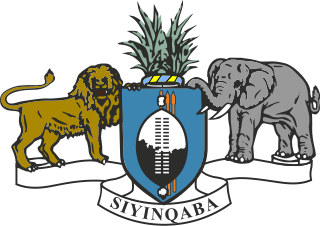
Eswatini, formally the Kingdom of Eswatini, also known by its former official name Swaziland and formally the Kingdom of Swaziland, is a landlocked country in Southern Africa. It is bordered by Mozambique to its northeast and South Africa to its north, west, south, and southeast. At no more than 200 km (120 mi) north to south and 130 km (81 mi) east to west, Eswatini is one of the smallest countries in Africa; despite this, its climate and topography are diverse, ranging from a cool and mountainous highveld to a hot and dry lowveld.

Eswatini, is a country in Southern Africa lying between Mozambique and South Africa. The country is located at the geographic coordinates 26°30′S31°30′E. Eswatini has an area of 17,363 square kilometres, of which 160 are water. The major regions of the country are Lowveld, Midveld and Highveld.

Manzini is a region of Eswatini, located in the center-west of the country. It has an area of 4,093.59 km2 and a population of 355,945 (2017). Its administrative center is Manzini. It borders all three other regions of Eswatini: Hhohho in the north, Lubombo in the east, and Shiselweni in the south. It is bordered by the Mpumalanga province in South Africa to the west.

Eswatini is divided into four regions: Hhohho, Lubombo, Manzini, and Shiselweni. Each region is further divided into tinkhundla. There are 55 tinkhundla in Eswatini and each elects one representative to the House of Assembly of Eswatini. Tinkhundla are, in turn, divided into smaller imiphakatsi.
The Lubombo Transfrontier Conservation Area was born out of the Peace Park Foundation’s vision to establish a network of transfrontier conservation areas in southern Africa. It straddles the border between South Africa’s KwaZulu-Natal province, southern Mozambique, and Eswatini.
Sobhuza I was king of Eswatini, from 1815 to 1850. Born around the year 1788, his father was King Ndvungunye, and his mother was Somnjalose Simelane. He was called Somhlolo, meaning "Mysterious man", upon his birth because his father, Ndvungunye, was struck by lightning. When Sobhuza was king, Lojiba Simelane, instead of his mother, Somnjalose was Queen Mother because Somnjalose was an inhlanti or support bride to Lojiba. Somhlolo is a greatly revered king of Eswatini. He had his first royal capital or kraal at Zombodze in the Shiselweni region, but moved it north to new Zombodze in central Eswatini. Swazis celebrate Somhlolo Day every September 6 as their Independence Day and the national stadium is named Somhlolo National Stadium. Sobhuza was succeeded by his son Mswati II and his wife Tsandzile Ndwandwe as Queen Mother after a short regency by Queen Lojiba Simelane. Sobhuza by the time of his death had conquered a country claimed to reach to modern day Barberton in the north, Carolina in the west, Pongola River in the south and Lubombo Mountains in the east.

The House of Assembly of Eswatini is the lower chamber of the country's bicameral Parliament. The Assembly may debate and pass bills, although as the country is an absolute monarchy, the role of the legislature is mostly advisory.
Siphofaneni is a town in the Lubombo Region of central Eswatini (Swaziland), 45 kilometres from Manzini and 20 kilometres from Big Bend, a major sugarcane-producing town on the main highway leading to Durban. It has a tropical climate, very hot during summer and cold in winter. Malaria is endemic in Lubombo. Siphofaneni has hot springs and is surrounded by several sugarcane farms. It is located on the banks of the largest river in Swaziland, the Usutu.
Simunye is a sugar mill town on the lowveld in eastern Eswatini. Almost all of the residents of the town work for the Royal Eswatini Sugar Corporation's sugar mill located nearby.
Lubhuku is a village in eastern Eswatini in Lubombo Region. It lies about 30 kilometres west of Siteki and 60 kilometres north of Big Bend and Mayaluka on the western side of the Lubombo Mountains.

The Mthethwa Paramountcy, sometimes referred to as the Mtetwa or Mthethwa Empire, was a Southern African state that arose in the 18th century south of Delagoa Bay and inland in eastern southern Africa. "Mthethwa" means "the one who rules".
Lonhlupheko is a community in Lugongolweni inkhundla, Lubombo Region, eastern Eswatini. It is located on a major junction on the MR3 road, between Siteki and Mpaka. The area is semi-arid and vulnerable to drought.
Protected areas of Eswatini include any geographical area protected for a specific use inside the landlocked country of Eswatini, in southern Africa.

Malolotja National Park covers 18,000 hectares of mountain wilderness on Eswatini's northwestern border with South Africa. The park includes Ngwenya Mountain, Eswatini's second highest mountain, and Malolotja Falls which drop 89 metres (292 ft), the highest in Eswatini. Habitats include short grassland to thick riverine shrub, bushveld and Afromontane forest.
Lubombo Conservancy-Goba Transfrontier Conservation Area is a joint project between Mozambique and Swaziland, based on the Peace Park agreements. The park will include the following area:
Tshaneni is a town in northern Eswatini (Swaziland), near the border post on the South African border.
Dvokodvweni is an inkhundla of Eswatini in the Lubombo District.
Lugongolweni is an inkhundla of Eswatini, located in the Lubombo District. Its population at the 2007 census was 15,519. It is divided into four umphakatsi, or chiefdoms: Ka-Langa, Makhewu, Mlindazwe, and Sitsatsaweni.
Matsanjeni North is an inkhundla of Eswatini, located in the Lubombo District. Its population at the 2007 census was 12,940.
Matata is a town in Eswatini.






